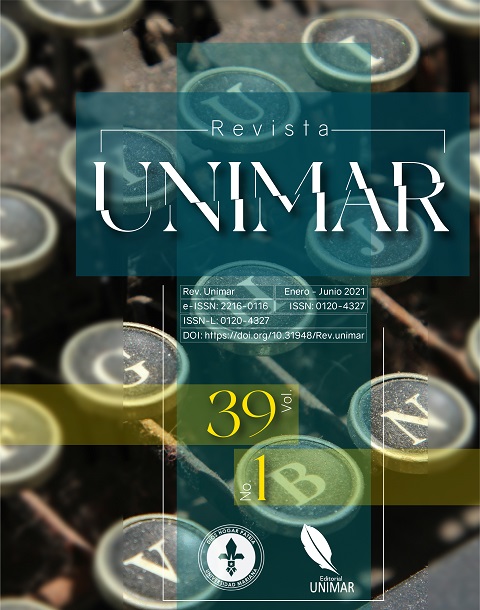Implementation of didactic sequences in the reading and writing process for 9th grade students at the San José Educational Institution in the municipality of Curumaní, Cesar
DOI:
https://doi.org/10.31948/Rev.unimar/unimar39-1-art1Keywords:
didactic sequence, reading and writing process, reading and writing skillsAbstract
The objective of this research was the development of reading and writing skills through the implementation of didactic sequences in the teaching-learning process in 9th grade students of the San José Educational Institution, in the municipality of Curumaní, Cesar. It was located in the qualitative paradigm, under the Pedagogical Action Research design, using the non-experimental method, which sought to generate transformation in the educational context from the application of didactic sequences. The selected group was evaluated through the didactic sequences implemented in the pedagogical events, direct observation, and the creation of a blog, concluding that, the didactic sequence in conjunction with the blog, facilitated the development of reading and writing skills for the ninth grade students, which contributed successfully not only with their process in the subject but in other areas of knowledge.
Author Biographies
Liyis Nerelsis López-Torres, Institución Educativa San José Curumaní, Cesar
Magíster en Pedagogía, Universidad Mariana. Especialista en Lúdica Educativa, Universidad Juan de Castellanos. Licenciada en Educación Primaria con énfasis en Español y Literatura, Universidad del Atlántico. Docente Titular de la I.E. San José Curumaní, Cesar, Colombia.
Katry Darlee Fragozo-Acosta, Colegio Windsor School
Magíster en Pedagogía, Universidad Mariana. Licenciada en Lengua Castellana e Inglés, Universidad Popular del Cesar. Docente colegio Windsor School.
References
Anónimo. (s.f.). Dormir en casa ajena. https://www.angelfire.com/ca5/mas/cuentos/mayas/c006.html
Baquero, M.A. (2018). Diseño didáctico para potencializar la comprensión lectora a través del juego dramático en el grado 4 01 de la Institución Educativa Rafael Valle Meza, sede Mixta 3, Valledupar Cesar (Tesis de Maestría). Universidad Santo Tomás. https://repository.usta.edu.co/bitstream/handle/11634/16415/2018mariabaquero.pdf?sequence=1&isAllowed=y
Barrera, C. (s.f.). Un pedazo de tierra. https://diarioinca.com/poema-un-pedazo-de-tierra-claudio-barrera
Calle. D. (s.f.). Instrumentos de Investigación Observación. https://es.calameo.com/books/00549746879505c011816
Carmon, J. (2007). Los blogs en el proceso de aprendizaje y evaluación. http://recursostic.educacion.es/artes/rem/web/index.php/eu/musica-educacion-y-tic/item/247-los-blogs-en-el-proceso-de-aprendizaje-y-evaluaci%C3%B3n
Cassany, D., Luna, M. y Sanz, G. (2003). Enseñar lengua (9.a ed.). Editorial Graó.
Chomsky, N. (1965). Aspectos de la teoría de la sintaxis (2.a ed.) Editorial Aguilar.
Cerrón, W. (2019). La investigación cualitativa en educación. Horizonte de la Ciencia, 9(17), 1-8. https://doi.org/10.26490/uncp.horizonteciencia.2019.17.510
Esopo. (s.f.). El león, la zorra y el ciervo. https://cuentoscortosparaniños.org/el-leon-la-zorra-y-el-ciervo/
Fernández, J. (2001). Elementos que conducen al concepto de profesión. Revista Electrónica de Investigación Educativa, 3(1).
Ferreiro, E. (1997). Alfabetización, teoría y práctica. Siglo XXI.
García, M. y Hernández, J.A. (s.f.). Quintiliano (ca. 35-ca. 96 d. C.) http://www.cervantesvirtual.com/portales/retorica_y_poetica/quintiliano/
Guerrero, L. y Esquivel, M. (2011). Lectura y escritura. En: Crispín, M.L. (Coord.), Aprendizaje autónomo: orientaciones para la docencia (pp. 85-103). Universidad Iberoamericana.
Hostos, Y. y Romero, A.D. (2017). Secuencia didáctica para el mejoramiento de la comprensión lectora en los estudiantes de 4°, 5° y 6° de la Institución Educativa Antonio Nariño - Nunchía (Casanare) (Tesis de Maestría). Universidad de La Salle.
Hernández-Sampieri, R. (2016). Capítulo 15 ‘Diseños del proceso de investigación’. https://administracionpublicauba.files.wordpress.com/2016/03/hernc3a1ndez-samipieri-cap-15-disec3b1os-del-proceso-de-investigacic3b3n-cualitativa.pdf
Likert, R.A. (1932). Technique for measurement attitudes. Archives of Psychology.
Marín, V., Muñoz, J.M. y Sampedro, B.E. (2014). Los blogs educativos como herramientas para trabajar la inclusión desde la educación superior. Ensayos, 29(2), 115-127.
Marshall, C. y Rossman, G.B. (2006). Designing qualitative research (4th ed.). Sage.
Morales, C. (2016). Programa de secuencias didácticas CICE para la creación de cuentos breves de los alumnos del cuarto grado de educación secundaria de la Institución Educativa “El señor es mi pastor”, 2015 (Tesis de Maestría). UNS, Escuela de Posgrados. http://repositorio.uns.edu.pe/bitstream/handle/UNS/3094/47097.pdf?sequence=1&isAllowed=y
Moreira, M.A. (s.f.). Unidades de Enseñanza Potencialmente Significativas - UEPS. http://www.if.ufrgs.br/~moreira/UEPSesp.pdf
Piaget, J. (1983). An interdisciplinary critique. Editorial Routledge.
Porter, L. (2001). Escribir como forma de aprender. http://academia.uat.edu.mx/porter/asesoria/escribir.htm
Pulido, M. (2009). Pensamiento complejo: una perspectiva para enseñar a pensar la historia en el contexto del aula. Ciencia y Sociedad, 34(2), 234-263. https://doi.org/10.22206/cys.2009.v34i2.pp234-263
Teberosky, A. y Ferreiro, E. (1978). Los sistemas de escritura en el niño. Siglo XX1 Editores.
Tobón, S., Pimienta, J. y García, J. (2010). Secuencia didáctica: Aprendizaje y evaluación de competencias. Pearson Educación.
Treviño, E., Pedroza, H., Pérez, G., Ramírez, P., Ramos, G. y Treviño, G. (2007). Prácticas docentes para el desarrollo de la comprensión lectora en primaria. Instituto Nacional para la Evaluación de la Educación.
How to Cite
Downloads
Downloads
Published
Issue
Section
License

This work is licensed under a Creative Commons Attribution 4.0 International License.
Los autores que publiquen en esta revista aceptan las siguientes condiciones:
1. Los autores conservan los derechos de autor y ceden a la revista el derecho de la primera publicación, con el trabajo registrado con la licencia de atribución de Creative Commons, que permite a terceros utilizar lo publicado siempre que mencionen la autoría del trabajo y a la primera publicación en esta revista.
2. Los autores pueden realizar otros acuerdos contractuales independientes y adicionales para la distribución no exclusiva de la versión del artículo publicado en esta revista (p. ej., incluirlo en un repositorio institucional o publicarlo en un libro) siempre que indiquen claramente que el trabajo se publicó por primera vez en esta revista.
3. Se permite y recomienda a los autores publicar su trabajo en Internet (por ejemplo en páginas institucionales o personales) antes y durante el proceso de revisión y publicación, ya que puede conducir a intercambios productivos y a una mayor y más rápida difusión del trabajo publicado (veaThe Effect of Open Access).
| Article metrics | |
|---|---|
| Abstract views | |
| Galley vies | |
| PDF Views | |
| HTML views | |
| Other views | |








